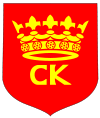Kielce
| Kielce | |||
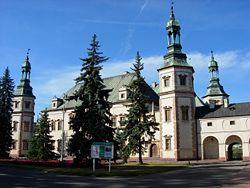 |
|||
|
|||
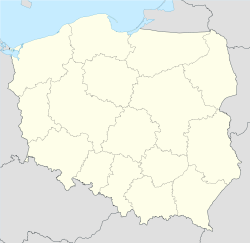 Kielce
|
|||
| Coordinates: | |||
| Country | |||
|---|---|---|---|
| Voivodeship | Świętokrzyskie | ||
| County | city county | ||
| Established | 11th century | ||
| Town rights | 1364 | ||
| Government | |||
| - Mayor | Wojciech Lubawski | ||
| Area | |||
| - City | 109.65 km² (42.3 sq mi) | ||
| Highest elevation | 408 m (1,339 ft) | ||
| Lowest elevation | 260 m (853 ft) | ||
| Population (2006) | |||
| - City | 207,718 | ||
| - Density | 1,894.4/km² (4,906.4/sq mi) | ||
| - Metro | 327,862 | ||
| Time zone | CET (UTC+1) | ||
| - Summer (DST) | CEST (UTC+2) | ||
| Postal code | 25-001 to 25-900 | ||
| Area code(s) | +48 41 | ||
| Car plates | TK | ||
| Website: http://www.um.kielce.pl | |||
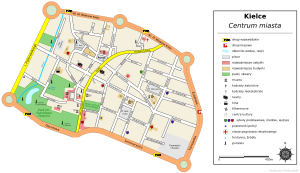


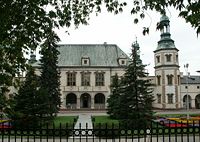

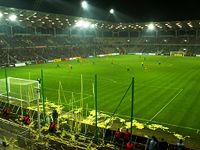
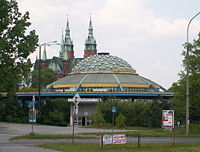
Kielce [ˈkʲɛlt͡sɛ] (![]() listen) is a city in central Poland with 202,609 inhabitants (2006). It is also the capital city of the Świętokrzyskie Voivodeship (Holy Cross Voivodeship) since 1999, previously in Kielce Voivodeship (1919–1939, 1945–1998). The city is located in the middle of the Świętokrzyskie Mountains (Holy Cross Mountains), at the banks of Silnica river. Once an important centre of limestone mining, Kielce is now a centre of trade and commerce.
listen) is a city in central Poland with 202,609 inhabitants (2006). It is also the capital city of the Świętokrzyskie Voivodeship (Holy Cross Voivodeship) since 1999, previously in Kielce Voivodeship (1919–1939, 1945–1998). The city is located in the middle of the Świętokrzyskie Mountains (Holy Cross Mountains), at the banks of Silnica river. Once an important centre of limestone mining, Kielce is now a centre of trade and commerce.
Contents |
History
The area of Kielce has been inhabited at least since 5th century BC. Until 6th or 7th century the banks of the Silnica were inhabited by Kelts who most probably were the name-sake for the location. They were driven out by a Slavic tribe of Vistulans who started hunting in the nearby huge forests and had settled most of the area now known as Małopolska and present-day Świętokrzyskie Voivodeship. The lands of Wiślanie were at first subdued by Bohemia, however they soon came under the power of the Piast dynasty and became a part of Poland. According to a local legend, Mieszko, son of Boleslaus II of Poland was attacked by a band of brigands in a forest. He was saved by a vision of Saint Adalbert. In the place of his vision he erected a wooden church.
In reality the area of the Holy Cross Mountains was almost unpopulated until 11th century when the first hunters established permanent settlements at the outskirts of the mountains. They needed a place to trade furs and meat for grain and other necessary products and so the market of Kielce was formed. In early 12th century the new settlement became a property of the Bishops of Kraków who built a wooden church and a manor. In 1171 a stone church was erected by bishop Gedeon Gryf. At the times of Wincenty Kadłubek a parochial school in Kielce was started in 1229. By 1295 the town was awarded with the city rights. In mid-13th century the town was destroyed by Mongol invasion of Ögedei Khan, but it quickly recovered.
The area around Kielce was rich in minerals such as copper ore, lead ore, and iron, as well as limestone. In 15th century Kielce became a significant centre of metallurgy. There were also several glass factories and armourer shops in the town. In 1527 bishop Piotr Tomicki founded a bell for the church and between 1637 and 1642 Renaissance palace was erected near the market place. It is one of the very few examples of French Renaissance architecture in Poland and the only example of a magnate's manor from the times of Vasa dynasty to survive the World War II.
During The Deluge the town was pillaged and burnt by the Swedes. Only the palace and the church survived, but the town managed to recover under the rule of bishop Andrzej Załuski. By 1761 Kielce had more than 4,000 inhabitants. In 1789 Kielce were nationalised and the burgers were granted the right to elect their own representatives in Sejm. Until the end of the century the city's economy entered a period of fast growth. A brewery was founded as well as several brick manufactories, a horse breeder, hospital, school and a religious college.
As a result of the 3rd Partition the town was annexed by Austria. During the Polish-Austrian War of 1809 it was captured by prince Józef Poniatowski and joined with the Duchy of Warsaw, but after the fall of Napoleon Bonaparte in 1815 it was joined with the Kingdom of Poland. For a brief period when Kraków was an independent city-state (Republic of Kraków), Kielce became the capital of the Kraków Voivodeship. Thanks to the efforts by Stanisław Staszic Kielce became the centre of the newly-established Old-Polish Industrial Zone (Staropolski Okręg Przemysłowy). The town grew quickly as new mines, quarries and factories were constructed. In 1816 the first Polish technical university was founded in Kielce. However, after Staszic's death the Industrial Zone declined and in 1826 the school was moved to Warsaw and became the Warsaw University of Technology.
In 1830 many of the inhabitants of Kielce took part in the November Uprising against Russia. In 1844 a priest Piotr Ściegienny intended a local uprising to liberate Kielce from Russian rule, for which he was sent to Siberia. In 1863 Kielce took part in the January Uprising. As a reprisal for insubordination the tsarist authorities closed all Polish schools and turned Kielce into a military garrison city. Polish language was banned. Because of that many gymnasium students took part in the 1905 Revolution and were joined by factory workers.
After the outbreak of World War I, Kielce were the first Polish city to be liberated from Russian rule by the Polish Legions under Józef Piłsudski. After the war when Poland regained its independence after 123 years of Partitions, Kielce became the capital of Kielce Voivodeship. The plans of strengthening of Polish heavy and war industries resulted in Kielce becoming one of the main nodes of the Central Industrial Area (Centralny Okręg Przemysłowy). The town housed several big factories, among them munitions factory "Granat" and food processing plant Społem.
During the Polish Defensive War of 1939 main part of the defenders of Westerplatte as well as armoured brigade of General Stanisław Maczek were either from Kielce or from its close suburbs. During the occupation that lasted for most of the World War II the town was an important centre of resistance. There were several resistance groups active in the town (among them the Armia Krajowa (AK) and the Gwardia Ludowa (GL)).
Notable acts of resistance[1]:
- Theft of 2 tons of TNT from the "Społem" college of higher education, which were then used by the partisans to make hand grenades.
- The daring escape from jail in Kielce of a dozen or so AK members, organised in November 1942 by Stanisław Depczyński.
- A grenade attack by a unit of the GL on the Smoleński coffee shop, killing 6 Germans including a major in the SS (February 1943).
- Assassination of the noted Gestapo officer Franz Wittek on 15 June 1944, by a unit under 2Lt. Kazimierz Smolak on the corner of Solna and Paderewskiego streets. One of the attackers died during the attack and a further four lost their lives not long afterwards. This was not the first assassination attempt against Wittek. Already in 1942 Henryk Pawelec fired at him in the market square, but his pistol misfired. In February 1943 a unit under the command of Stanisław Fąfar shot at Wittek by the Seminarium building, but Wittek, although wounded by 14 bullets, survived.
- Successful assassinations of local collaborators, including the shooting of Jan Bocian in broad daylight in a shop in Bodzentyńska street.
- An attack on the factory of C. Wawrzyniak in March 1943, terrorizing and disarming the volksdeutscher workers and destroying the machinery.
- An attack on the "Hasag" factory in May 1943 and the takeover of the Kielce Herbskie railway station.
Moreover, the hills and forests of Holy Cross Mountains became a scene of heavy partisan activity. A small town of Pińczów located some 30 kilometres from Kielce became the capital of the so-called Pinczów Republic, a piece of Polish land controlled by the partisans. The Swietokrzyskie Mountains Home Army District fought against the Germans long before the Operation Tempest started inflicting heavy casualties on the occupying forces and later taking part in the final liberation of their towns and cities in January 1945. During the war many of inhabitants of Kielce lost their lives.
On 4 July 1946 Kielce was the unfortunate venue of an antisemitic pogrom that left 37 Jews killed by local polish population after allegations of blood libel.
Today, Kielce is a rapidly developing city, of growing regional importance.
Jews
On the eve of the Second World War there were 24,000 Jewish inhabitants in Kielce, which were around one-third of the population at the time. Immediately after the German occupation in September 1939 action have been taken against the Jews - fines, confiscation of property, forced labour, etc' were forced on the Jewish population. In April 1941 the Jewish ghetto was established and the Jews were forced to move into it. Many of the Jews were forced labour at a German ammunition plant. In August 1942 the extermination of the Jewish ghetto has started and in 5 days all the Jews in the ghetto but 2,000 Jews who were sent to another forced labour camp were sent to the Treblinka extermination camp.
After the war some of the Jews came back to Kielce but on July 4, 1946 after an allegations of blood libel over 35 Jews were murdered by the local polish population, see Kielce pogrom.
Tourists attractions
- Palace of Cracow Bishops (1637–1641): summer residence of Bishops of Cracow, built in early baroque style; houses a museum with an important gallery of Polish paintings
- Baroque Cathedral (12th century, rebuilt 1632–1635 and again in 19th century)
- Holy Trinity Church (1640–1644)
- Tomasz Zieliński romantic manor (1846–1858)
- Old Town market (18th century)
- Sienkiewicza Street
- Stefan Żeromski museum
- Synagogue (renaissance)
- 5 geological nature reserves in town area
- Kadzielnia Gorge (a former quarry where many of the East German westerns were shot) - including parts of the
- Holy Cross Mountains
Education
- Politechnika Świętokrzyska (Kielce University of Technology) [1]
- Akademia Świętokrzyska im. Jana Kochanowskiego (Jan Kochanowski University) [2]
- Swietokrzyska Szkola Wyzsza
- Wszechnica Swietokrzyska
- Wyzsza Szkola Administracji Publicznej
- Wyzsza Szkola Ekonomii i Prawa im. prof. Edwarda Lipinskiego www
- Wyzsza Szkola Handlowa im. Boleslawa Markowskiego
- Wyzsza Szkola Umiejetnosci
- Wyzsza Szkola Technik Komputerowych i Telekomunikacji
- Wyzsza Szkola Zarzadzania Gospodarka Regionalna i Turystyka
- Wyzsza Szkola Telekomunikacji i Informatyki www
- Towarzystwo Wiedzy Powszechnej OR Kielce
- Juliusz Słowacki High School www
- Stefan Żeromski High School www
- Jan Śniadecki High School [3]
- Hanka Sawicka High School
- św. Jadwiga Królowa High School
Culture
Cinemas
Theatres
- Stefan Żeromski Theatre www
- Kieleckie Centrum Kultury - KCK www
- "Kubuś" - The puppet and actor Theatre www
Sports
- Korona Kielce - men's football team, promoted to 2nd league in season 2004/2005. Qualified to the 1st league (Orange Ekstraklasa) in 2005/2006, when they completed their new, modern stadium. Currently relegated to 1st Polish League (former Second League).
- Vive Kielce (Iskra Kielce) men's Handball team playing in Polish Ekstraklasa Mens's Handball League, few times Champions and medalist of Poland (winner in 1993 1994 1996 1998 1999 2003, second places in 1995 2004, third places in 1980 1997 2001 2005 ) .
- KKL Kielce (athletics) - Official website of KKL Kielce
- Oficina da Capoeira Kielce - Capoeira Club in Kielce
- Muay Thai Kielce
- Żak Kielce (judo club)
- Kielecki Klub Karate Kyokushin
- Rushh Kielce (boxing club)
- Gwardia Kielce (boxing club)
- KS FART Kielce (volleyball club)
- Orlęta Kielce (football club, IV league)
- Polonia Białogon Kielce (football club)
- Czarnovia Kielce (football club)
- AZS Politechnika Kielce (football club)
- AZS WSU Kielce (football club)
- Scyzory Kielce (American football)
- Tęcza Kielce
- Mountain biking in Kielce
- Contact Kielce billiards club from Kielce, Champion of Poland and medalist of Polish League
Twin Towns - Sister Cities
Kielce is twinned with:
Politics
Kielce constituency
Members of Parliament (Sejm) elected from Kielce constituency in 2005:
- Przemysław Gosiewski, PiS (votes: 31253)
- Konstanty Miodowicz, PO (14505)
- Włodzimierz Stępień, SLD (12655)
- Małgorzata Olejnik, Samoobrona (12398)
- Józef Cepil, Samoobrona (10526)
- Krzysztof Grzegorek, PO (8730)
- Radosław Parda, LPR (7856)
- Leszek Sułek, Samoobrona (7590)
- Mirosław Pawlak, PSL (6684)
- Halina Olendzka, PiS (5386)
- Henryk Milcarz, SLD (5251)
- Andrzej Pałys, PSL (5055)
- Krzysztof Lipiec, PiS (4697)
- Jarosław Rusiecki, PiS (4009)
- Zbigniew Pacelt, PO (3982)
- Maria Zuba, PiS (3397)
Famous people
- Czeslaw Biezanko, Polish entomologist
- Gustaw Herling-Grudzinski, writer
- Stefan Żeromski, writer
- Przemysław Gosiewski, politician
- Adolf Dygasiński, writer
- Jan Czarnocki, geologist
- Edmund Niziurski, writer
- Rafał Olbiński,Polish graphic artist, stage designer and surrealist painter
- Stanisław Staszic, Polish priest, philosopher, statesman, poet and writer, a leader of the Polish Enlightenment
- Krzysztof Klicki, president of Kolporter Holding, owner of Korona Kielce
- Michał Sołowow, businessman, shareholder of: Cersanit S.A., Echo Investment, Barlinek, Życie Warszawy, one of the richest Polish people
- Leszek Drogosz, boxer, 3 times European Champion, Olympic medalist
- Wincenty z Kielc
- Krzysztof "K.A.S.A" Kasowski vocalist
- Piotr Marzec better known as Liroy (Leeroy), rapper
- Andrzej Piaseczny vocalist
- Leszek Kumański writer, journalist, stage manager
- Wiesław Gołas actor
- Dagmara Dominczyk
- Marika Dominczyk
Sportsmen
- Paweł Brożek footballer (Polonia Białogon, GKS Katowice, Wisła Kraków)
- Leszek Drogosz boxer
- Zbigniew Piątek cyclist
- Piotr Stokowiec (Orlęta Kielce, Polonia Warszawa,Wigry Suwałki)
- Michał Sołowow rally driver
References
- ↑ Historia Kielc (History of Kielce, in Polish Wikipedia)
External links
- Kielce Classifieds
- Website of Kolporter Korona Kielce
- Municipal website
- WICI Portal of Culture in Kielce - Polish language only
- Kielce travel guide from Wikitravel
- Website about new constructions in Kielce - Polish language only
- Historic gallery of Kielce - Old Kielce on photos (Pl, En)
- Trade Fair Kielce
- XVII century historical re-enactment group: Kompania Wolontarska
|
|||||||
|
||||||||||
|
||||||||||||||
